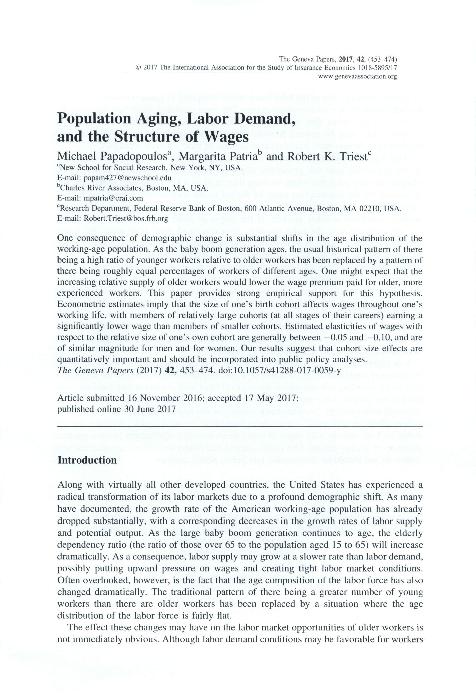Population aging, labor demand, and the structure of wages

Contenido multimedia no disponible por derechos de autor o por acceso restringido. Contacte con la institución para más información.
| Tag | 1 | 2 | Valor |
|---|---|---|---|
| LDR | 00000cab a2200000 4500 | ||
| 001 | MAP20170026914 | ||
| 003 | MAP | ||
| 005 | 20170825124137.0 | ||
| 008 | 170818e20170630che|||p |0|||b|eng d | ||
| 040 | $aMAP$bspa$dMAP | ||
| 084 | $a40 | ||
| 100 | $0MAPA20170010692$aPapadopoulos, Michael | ||
| 245 | 1 | 0 | $aPopulation aging, labor demand, and the structure of wages$cMichael Papadopoulos, Margarita Patria, Robert K. Triest |
| 300 | $a22 p. | ||
| 520 | $aOne consequence of demographic change is substantial shifts in the age distribution of the working-age population. As the baby boom generation ages, the usual historical pattern of there being a high ratio of younger workers relative to older workers has been replaced by a pattern of there being roughly equal percentages of workers of different ages. One might expect that the increasing relative supply of older workers would lower the wage premium paid for older, more experienced workers. This paper provides strong empirical support for this hypothesis. Econometric estimates imply that the size of one's birth cohort affects wages throughout one's working life, with members of relatively large cohorts (at all stages of their careers) earning a respect to the relative size of one's own cohort are generally between -0.05 and -0.10, and are of similar magnitude for men and for women. Our results suggest that cohort size effects are quantitatively important and should be incorporated into public policy analyses. | ||
| 650 | 4 | $0MAPA20080553883$aDemografía | |
| 650 | 4 | $0MAPA20080545581$aTrabajo | |
| 700 | 1 | $0MAPA20170010708$aPatria, Margarita | |
| 700 | 1 | $0MAPA20170010715$aTriest, Robert K. | |
| 773 | 0 | $wMAP20077100215$tGeneva papers on risk and insurance : issues and practice$dGeneva : The Geneva Association, 1976-$x1018-5895$g03/07/2017 Volumen 42 Número 3 - julio 2017 , p. 453-474 |

